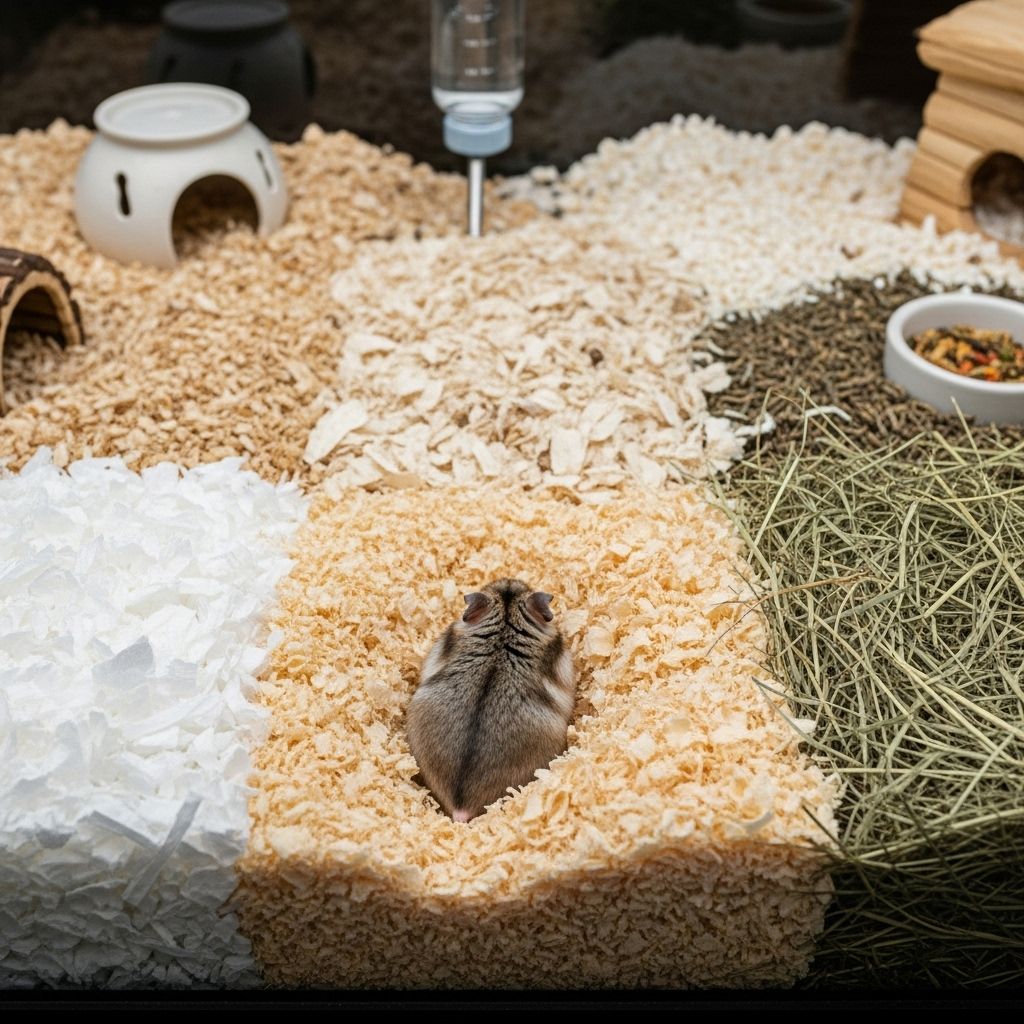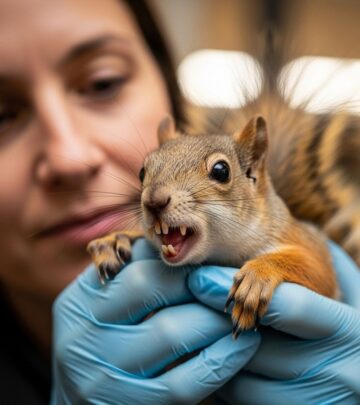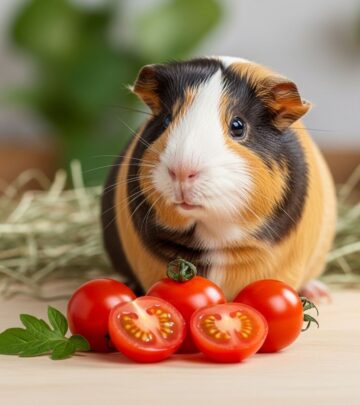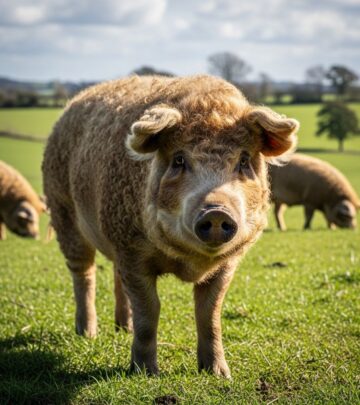Hamster Bedding: 6 Safe Types, Setup Tips, And Care Guide
Deep substrate supports natural digging and enhances pet wellbeing.

The Essential Guide to Hamster Bedding: Types, Safety, and Care
Hamsters are delightful, inquisitive pets that rely on safe, comfortable bedding to stay healthy and happy. Bedding is more than just a place for your hamster to rest—it forms the environment in which they burrow, nest, and play. However, not all bedding options are created equal. Choosing the wrong material can cause health concerns, poor hygiene, or discomfort. In this comprehensive guide, you’ll learn everything you need to know about hamster bedding, including types, safety considerations, tips for setup, and expert advice for maintaining a cozy, inviting habitat.
Why Bedding Matters for Hamsters
Proper bedding is critical for a hamster’s physical and psychological well-being. The right bedding:
- Supports natural burrowing instincts
- Absorbs moisture and controls odors
- Provides insulation for warmth
- Reduces stress and promotes healthy nesting behavior
Without the right bedding, hamsters can develop health problems, experience unnecessary stress, and struggle to express their natural behaviors.
What Makes Bedding Safe or Unsafe?
Before choosing bedding, always check that it is:
- Free from harmful chemicals, scents, or dyes
- Non-toxic, dust-free, and absorbent
- Not made from sharp or fibrous material that could injure your hamster
Safe bedding supports a hamster’s sensitive respiratory system and prevents ingestion of dangerous substances. Bedding labeled for ‘small animals’ isn’t always suitable for hamsters specifically—always verify with a trusted resource.
Types of Hamster Bedding
Not all bedding is created equal. Here are the most common bedding types you’ll encounter, with detailed pros and cons for each:
Paper-Based Bedding
Paper-based bedding is widely recommended due to its combination of softness, absorbency, and safety. Commercial products made from recycled paper are usually free from toxic inks or chemicals. Options include:
- Clumped tissue-like bedding (usually white, brown, or color-safe)
- Shredded plain toilet paper or unprinted paper towels
Advantages:
- Soft, ideal for burrowing and nesting
- Good odor and moisture control
- Low dust – suitable for sensitive respiratory systems
- Biodegradable and easy to dispose of
Disadvantages:
- Some brands may use unsafe dyes or chemicals—always choose unscented, unbleached options
- May require more frequent cleaning compared to some other options
Aspen Shavings
Aspen shavings are the only type of wood shavings broadly recognized as safe for hamsters. Many commercial small animal beddings contain aspen because it’s low in natural oils that can harm pets.
Advantages:
- Natural odor control
- Affordable and widely available
- Good for digging and burrowing
Disadvantages:
- Shavings may stick to long-haired hamsters’ fur
- May be a little coarse for very young or sensitive hamsters
- Must ensure it is free from chemical additives
Hemp Bedding
Hemp bedding is gaining popularity as a hypoallergenic, eco-friendly option. Made from natural hemp fibers, it’s known for its softness, high absorbency, and low dust levels—making it excellent for hamsters and their human caretakers with allergies.
Advantages:
- Highly absorbent and controls odor efficiently
- Compostable and sustainable (hemp is a regenerative crop)
- Gentle on delicate paws
Disadvantages:
- Can be harder to find and more expensive than standard paper or wood options
Hay Bedding
Hay (such as timothy, orchard grass, or oat hay) is sometimes used as a supplementary layer. Hamsters can nibble, build tunnels, and add texture to their habitats with hay.
Advantages:
- Safe to eat in moderation (not a primary food source)
- Good for supporting burrow structures
- Enriches sensory experience
Disadvantages:
- Some types (like timothy) may have sharp pieces—choose soft varieties to reduce injury risk
- Not very absorbent on its own, best combined with other bedding
Soft Granule and Paper Pellet Bedding
These products are made from compressed or granulated paper or safe recycled materials and are commercially available for small animals.
Advantages:
- Low dust and gentle for sensitive hamsters
- Compostable and often made from recycled materials
Disadvantages:
- Doesn’t support burrowing or tunnel-making well—best as a base layer with other bedding on top
DIY Bedding (Toilet Paper and Unprinted Paper Towels)
Soft, unscented, white toilet paper or unprinted paper towels can be shredded to create an affordable, DIY bedding solution. This is a good option in emergencies or to supplement other beddings.
Advantages:
- Readily available and inexpensive
- Completely safe if plain and free from dyes or printing
Disadvantages:
- Needs very frequent changing due to low absorbency
- Not ideal as the only bedding for a whole habitat
Bedding Materials to Avoid
Some bedding materials may look safe but can cause serious health problems for your hamster. Never use:
- Pine or Cedar Shavings: These woods release aromatic oils that can harm hamsters’ respiratory systems and livers—even if marketed as ‘dust-free’ or ‘kiln-dried’.
- Fluffy Bedding (Cotton, Wool, Fiber Fill): Soft, cotton wool or ‘fluffy’ beddings pose a high risk of digestive blockages and can tangle around little limbs, leading to serious injury or loss of circulation.
- Scented Bedding: Artificial fragrances can irritate your hamster’s sensitive nose and lungs, causing sneezing, coughing, or long-term harm.
- Shredded Newspaper or Glossy Paper: Inks, particularly colored or glossy inks, are toxic if ingested.
- Hardwood Chips (besides aspen): Many hardwoods contain phenols and resins that are unsafe for hamsters.
How Much Bedding Does My Hamster Need?
Hamsters are instinctual diggers and need deep substrate for burrowing. Aim to provide at least 6 inches (15 cm) of bedding—some species, like Syrian hamsters, benefit from even deeper layers. More bedding means more comfort, warmth, and better odor control.
Create different zones of depth throughout the habitat: higher in some areas for deeper burrows, lower in spots for tunnels and nest spaces.
Setting Up the Perfect Hamster Habitat
For the happiest, healthiest hamster, keep these bedding setup tips in mind:
- Layer bedding generously: Aim for 6–10 inches for most breeds. Mix soft paper, aspen, and a bit of hay for texture variety.
- Spot-clean daily: Remove soiled bedding from bathroom and nest areas every day to manage hygiene and odor.
- Thoroughly replace bedding weekly: Once a week, replace about half the bedding, and do a full cage cleaning every 2–4 weeks to reduce stress from sudden changes.
- Add enrichment: Scatter treats, hay, or small toys under the bedding to encourage natural foraging behavior.
How to Introduce New Bedding
When you switch bedding brands or types, do so gradually to prevent stress:
- Mix a small amount of the new bedding with the existing bedding over several cage cleanings.
- Monitor your hamster for sneezing, itching, or changes in behavior, which can indicate allergies.
- If your hamster reacts negatively, return to the previous safe bedding and consult a veterinarian.
Choosing Eco-Friendly and Sustainable Bedding
More hamster owners are choosing eco-friendly bedding—such as hemp, recycled paper, or natural aspen—to lower their environmental impact. When shopping:
- Look for bedding made from renewable, compostable materials.
- Avoid plastic-based or artificially colored products.
- Check for seals of approval or third-party environmental certifications.
Quick Comparison Table: Pros and Cons of Popular Bedding Types
| Bedding Type | Pros | Cons |
|---|---|---|
| Paper-Based | Soft, absorbent, safe, easy cleanup | Some brands use dyes; lower odor control than hemp |
| Aspen | Natural, affordable, supports burrowing | Can be coarse for babies; sticks to long fur |
| Hemp | Eco-friendly, hypoallergenic, high absorbency | Expensive, harder to source |
| Hay | Edible, enriches habitat, supports tunnels | Can poke; not a standalone bedding |
| Soft Granule/Paper Pellet | Low dust, compostable, gentle | Poor tunneling—best as a layer |
Health Risks of Unsafe Bedding
Using unsafe bedding can lead to significant health issues for your hamster, such as:
- Respiratory problems: Caused by dust, aromatic oils, or chemical residues
- Digestive blockages: Especially from ingesting fluffy/cotton bedding
- Allergic reactions and skin irritation: Look for signs like scratching, sneezing, or fur loss
- Injury: Sharp or rough bedding can damage feet or eyes
If you notice your hamster sneezing, wheezing, limping, or behaving abnormally, change the bedding immediately and consult with an exotic pet vet.
Frequently Asked Questions (FAQs)
Q: What’s the best bedding for hamsters with allergies?
A: Dust-free, hypoallergenic bedding like hemp or unscented paper-based bedding is safest for sensitive hamsters and their caretakers.
Q: Can I use recycled newspaper bedding?
A: Commercial recycled paper bedding is generally safe. Avoid using shredded home newspapers, which can contain toxic inks and chemicals.
Q: How often should I change my hamster’s bedding?
A: Spot-clean daily and do a partial bedding change weekly. Full deep-cleans (replacing all bedding) are typically needed every 2–4 weeks.
Q: Is it okay to mix different types of bedding?
A: Yes, layering paper-based bedding with a bit of hay or aspen increases texture and supports burrowing, provided all types chosen are safe.
Q: Can I use fluffy or cotton wool bedding if it’s labeled ‘safe for small pets’?
A: No, avoid all fluffy or cotton bedding for hamsters. Despite marketing claims, these products are dangerous due to risks of digestive blockages or entanglement.
Final Tips for a Happy, Healthy Hamster
- Research bedding brands before purchase. Check reviews and look for hamster-specific recommendations.
- Keep cage enrichment and bedding refreshes regular to keep your hamster curious and healthy.
- Always monitor your hamster’s behavior after switching bedding, and consult a vet if anything seems off.
With the right substrate, your hamster will thrive—burrowing, nesting, and exploring in a home that is safe, cozy, and clean!
References
- https://happyhabitats.net/blogs/blog/the-different-types-of-hamster-bedding
- https://www.hempbedding.com/blog/how-to-choose-hamster-bedding/
- https://www.petassure.com/maxscorner/what-type-of-bedding-is-best-for-hamsters/
- https://qualitycage.com/blogs/hamster-care/how-to-choose-the-best-bedding-for-hamsters-a-2023-guide
- https://www.hamsterwelfare.com/safe-unsafe-hamster-bedding/
Read full bio of Shinta












